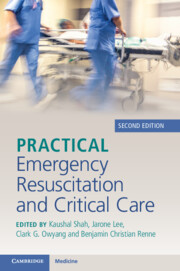Book contents
- Practical Emergency Resuscitation and Critical Care
- Practical Emergency Resuscitation and Critical Care
- Copyright page
- Contents
- Contributors
- Preface
- Section 1 General Critical Care
- Section 2 Infectious Disease Emergencies
- Section 3 Neurological Emergencies
- 12 Ischemic Strokes
- 13 Intracranial Hemorrhage
- 14 Status Epilepticus
- 15 Acute Spinal Cord Compression
- Section 4 Cardiovascular Emergencies
- Section 5 Respiratory Emergencies
- Section 6 Gastrointestinal Emergencies
- Section 7 Renal Emergencies
- Section 8 Hematology–Oncology Emergencies
- Section 9 Endocrine Emergencies
- Section 10 Environmental Emergencies
- Section 11 Trauma
- Section 12 End of Life
- Index
- References
13 - Intracranial Hemorrhage
from Section 3 - Neurological Emergencies
Published online by Cambridge University Press: 02 November 2023
- Practical Emergency Resuscitation and Critical Care
- Practical Emergency Resuscitation and Critical Care
- Copyright page
- Contents
- Contributors
- Preface
- Section 1 General Critical Care
- Section 2 Infectious Disease Emergencies
- Section 3 Neurological Emergencies
- 12 Ischemic Strokes
- 13 Intracranial Hemorrhage
- 14 Status Epilepticus
- 15 Acute Spinal Cord Compression
- Section 4 Cardiovascular Emergencies
- Section 5 Respiratory Emergencies
- Section 6 Gastrointestinal Emergencies
- Section 7 Renal Emergencies
- Section 8 Hematology–Oncology Emergencies
- Section 9 Endocrine Emergencies
- Section 10 Environmental Emergencies
- Section 11 Trauma
- Section 12 End of Life
- Index
- References
Summary
Intracranial hemorrhage (ICH) occurs when blood occupies space within the calvarium. ICH irritates brain parenchyma and impairs outflow of cerebral spinal fluid (CSF) from the dural sinus venous network, which raises intracranial pressure (ICP) with a resultant decrease in cerebral perfusion.
ICH types are defined by the location of the bleeding: intracerebral (within the parenchyma), epidural (between the skull and the dura), subdural (between the dura and arachnoid membrane) and subarachnoid (between arachnoid membrane and pia mater).
The skull is inelastic, so blood accumulation increases intracranial pressure.
- Type
- Chapter
- Information
- Practical Emergency Resuscitation and Critical Care , pp. 114 - 123Publisher: Cambridge University PressPrint publication year: 2023

